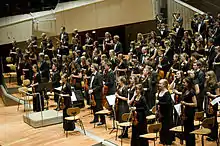Bundesjugendorchester
The Bundesjugendorchester (Federal Youth Orchestra, BJO; German: [ˌbʊndɛs ˈjuːgɛnt ɔrˌkɛstər]) is one of the national youth orchestras of Germany. Unlike the Junge Deutsche Philharmonie, which consists of conservatory students up to the age of 28, the Bundesjugendorchester is composed of pre-university students aged 14–19.[1] It is supported by the project company of the Deutscher Musikrat[2][3] and is based in Bonn. It was established in 1969, making it one of the oldest national youth orchestras in the world.[4]
| Bundesjugendorchester | |
|---|---|
| Youth orchestra | |
| Founded | 1969 |
| Location | Bonn |
| Website | www |

The orchestra features young German musicians under the baton of renowned conductors such as Herbert von Karajan, Kurt Masur, Gerd Albrecht, Carl St. Clair, Steven Sloane, Eiji Ōue, Kirill Petrenko[5] and Simon Rattle. The musicians qualify for membership by auditioning in front of a jury. During the work phases, the orchestra works under the guidance of private teachers, including members of the Berlin Philharmonic, and the respective conductor. The programme includes classical and romantic orchestral music, contemporary works by composers such as Hans Werner Henze and Karl Amadeus Hartmann as well as world premieres by Peter Ruzicka and Bernd Franke, among others.[6][7][8]
Every year, three- to four-week work phases are carried out, followed by a concert tour. Rotating conductors are in charge of the artistic direction. In addition, there are short-term special projects. Many former members now play in professional orchestras or have become well-known soloists.
In 2013, to mark the 50th anniversary of the Élysée Treaty, the Bundesjugendorchester performed a series of concerts together with its French counterpart, the Orchestre Français des Jeunes, under the direction of Dennis Russell Davies.[9]
It is a member of the European Federation of National Youth Orchestras.[10]
See also
References
- 50 Jahre Bundesjugendorchester
- Bundesjugendorchester
- Bundesjugendorchester Young Euro Classic 2019
- Fulker, Rick. "Germany's National Youth Orchestra at 50". Deutsche Welle. Retrieved 15 December 2020.
- Kirill Petrenko dirigiert das Bundesjugendorchester
- Bundesjugendorchester: Petrenko dirigiert Konzert on NDR.de
- Bundesjugendorchester on T.Online.de
- 2019 Konzerte
- "Deutsche und französische Jugendorchester beim Élysée-Jubiläum". MUSIK HEUTE (in German). 15 August 2013. Retrieved 10 December 2020.
- European Federation of National Youth Orchestras. "Members&Partners". Retrieved 9 December 2020.
External links
- Bundesjugendorchester discography at Discogs